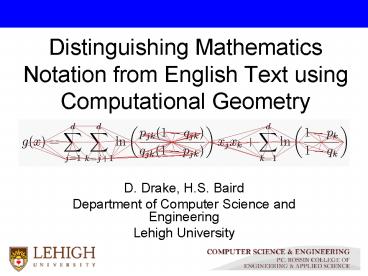Distinguishing Mathematics Notation from English Text using Computational Geometry - PowerPoint PPT Presentation
Title:
Distinguishing Mathematics Notation from English Text using Computational Geometry
Description:
Distinguishing Mathematics Notation from English Text using Computational ... 77 node binary features. 2926 quadratic binary features (ANDing pairs of features) ... – PowerPoint PPT presentation
Number of Views:22
Avg rating:3.0/5.0
Title: Distinguishing Mathematics Notation from English Text using Computational Geometry
1
Distinguishing Mathematics Notation from English
Text using Computational Geometry
- D. Drake, H.S. Baird
- Department of Computer Science and Engineering
- Lehigh University
2
The Task
- Differentiate isolated math and English textlines
English text or Math?
English text or Math?
How can Optical Character Recognition (OCR)
systems make this distinction? (a) math
symbols (b) spatial arrangement
3
Applications of Textline Classification
- Commercial OCR systems far better on text than
on math - e.g. OCR systems still garble math
- Textline classification allows
- Processing of text/math differently
- Hand off math to special purpose recognizers
- Users can see Math textlines as image
- No OCR errors
4
Prior Work
- Past approaches
- Symbol recognition
- plus spatial analysis
Our approach Purely spatial analysis
Requires a classifier for special math symbols Often sensitive to font font size text orientation language Independent of font font size text orientation Easily extendable to other languages But may not handle as many cases-lets see
5
Voronoi Diagrams
Given a set of point sites in the
plane, Partition the plane into regions such that
the points in each region are closer to one site
than any other
A computational geometry data structure which is
invariant under arbitrary nonsingular similarity
transformations (translation, rotation,
scaling) --- and is efficiently computable
6
We use Kises Area Voronoi diagrams
Input Image
Sample points on boundary of black connected
components
Compute Voronoi Diagram
Compute Area Voronoi Diagram
Compute Neighbor Graph
Input to our classifier decides whether
textline is math or text
7
Kises algorithm run on math notation
8
Features of the Neighbor Graph we use for
Classification
- Crafted to detect spatial arrangements among
characters that distinguish math from text
- Edge Features
- angle (wrt horizontal)
- ratio of areas
- ratio of diameters
- shadowing
- Node Features
- aspect ratio
- diameter/area ratio
- fanout
Coarsely quantized Binary-valued presence (1)
or absence (0)
9
Classifier design
- 77 node binary features
- 2926 quadratic binary features (ANDing pairs of
features) - assume class-conditional independence among
quadratic features - trained a Bayesian node classifier
- 29 edge binary features
- 406 quadratic binary features (pairs of features)
- assume class-conditional independence among
quadratic features - trained a Bayesian edge classifier
- Combined results into a textline classifier
- Runs fast 0.072 CPU sec per textline on average
- (on a 650 MHz SunBlade) not optimized for
speed
10
Training Test data
- Collected 264 images of textlines
- from scanned math books
- also, synthesized using LaTeX
- Training set
- 132 textlines 68 math, 64 text
- 7273 nodes total 2273 math, 5000 text
- 9358 edges total 3827 math, 5531 text
- Test set
- 132 textlines 68 math, 64 text
- 7072 nodes total 2269 math, 4803 text
- 9322 edges total 4005 math, 5317 text
- (A small, preliminary trial.)
11
Examples of Correctly Classified Textlines
12
Results
- Experiment performed on synthetically-generated
images and scanned books
Classified as True class Math Text
Math 67 1
Text 0 64
Data Set True class Training Testing
Math 0.029 0.015
Text 0.000 0.000
Overall 0.015 0.008
Confusion Matrix
Error Rates
Examples of misclassified textlines
13
Summary
- Analysis of spatial arrangements (without symbol
recognition) handles many cases - Automatically trainable
- Needs no prior knowledge of font, font size, or
spacing - Far less effort to train spatial classifiers than
to build a recognizer for math symbols in all
typefaces, sizes, etc - Possibly easily extendable to (trainable on)
other languages than English
14
Future Work
- Locate inline math
- Mop up failure cases by adding a few more simple
spatial features - Speed up (if desirable) by pruning features
15
Acknowledgements
- Koichi Kise, Osaka Prefecture University
- for generously contributed advice and code
- --------------------------------------------------
-------------
Derek Drake who, after all, did all the work
who by rights should be giving this talk
but hes starting the CS PhD program at
Purdue Univ. this week






























